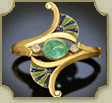antique-jewelry-lecture-alloys
Antique jewelry: alloys and metal standards

What is an alloy and what can you achieve by influencing it? Which alloy is better and which worse? Which is worth more or less? etc. etc.
An alloy is a mixture of different metals, which for jewelry has to contain a certain minimum amount of gold, silver or platinum.
Pure gold is also called 24 karat, 999/1000 or 100% fine. 14 karat has 14 of the 24 parts being gold (585/1000 or 58½%) and the remaining 10/24 (or 41½%) other metal(s) used to control the characteristics of the alloy, like colour, hardness, flexibility, elasticity, etc. It can be obvious why someone wants to influence a characteristic like colour, but there are other matters not as obvious but important nevertheless for the expert who wants to influence in the characteristics of an alloy.
One example is if the gold is to be used to create a spring (which will have to stay sprung over a long period of time). Naturally such an alloy has to be more elastic then the flexible alloy in which a goldsmith or silversmith has to press a shape (the difference between a gold- or silversmith).
Although 1 gram of 22K is worth more then 1 gram of a lesser alloy, the jewel made from 22K gold will wear down easier then those made of a lower alloy (gold being the soft metal that it is).
That in these days the different countries do not have one standardized alloy, finds its origin in old national laws, guilds (going back to the middle ages) and old habits. One cannot say that one alloy is explicitly better then the other. Of course there is a difference in intrinsic value, simply because there is more or less gold in one alloy then the other; but to call one alloy better then the other doesn't make much sense. One could say, "when in Rome, do as the Romans do".
Sterling silver, which has 925/1000 parts pure silver in its alloy, is no worse then French silver with has 950/1000 parts silver and neither of these are better then German (800/1000) or Danish silver (830/000). The difference in value too is minimal even in larger quantities like kilograms. It's my believe that you will find that many people who prefer a certain type of silver over another rather have chauvinistic reasons then real technical arguments for this.
Platinum is normally being used in a rather high standard (950/1000).








